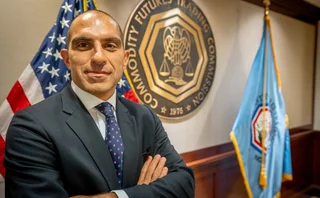
Libor’s legion of successors

The countdown to Libor’s demise is officially under way. On December 31, most settings, including sterling and yen, will cease. At the same time, widely used US dollar settings, which were granted an 18-month reprieve, will no longer be available for new business.
If a recent jump in Libor usage is anything to go by, regulators face a Herculean task prising dollar markets from the discredited rate by year-end. Exposures linked to US dollar Libor totalled $223 trillion at the end of 2020 – up from $199 trillion four years earlier, according to estimates from the Alternative Reference Rates Committee (ARRC), the Federal Reserve-backed group tasked with transitioning US markets off Libor.
In April, just 7.5% of US dollar swaps risk was traded on the secured overnight financing rate (SOFR), the Fed’s preferred Libor successor, according to the Isda-Clarus RFR Adoption Indicator.
The mission is complicated by huge swathes of the US lending market, which is yet to be convinced by SOFR. Many would prefer something altogether more ‘Libor-like’ – and the market seems determined to offer them a growing menu of alternatives to choose from.
At least three new benchmarks offer the credit sensitivity and term structure inherent to Libor. Lenders have already begun to adopt two of them: Ameribor and Bloomberg’s short-term bank yield index, or BSBY. IHS Markit recently made its credit bank funding benchmark live, and two more vendors are waiting in the wings.
While US regulators have been relatively quiet on the thorny issue of credit-sensitive rates (CSRs), criticism by their UK counterparts has ramped up. Speaking at a March 21 SOFR symposium, Bank of England governor Andrew Bailey warned that CSRs built on thin and incomplete markets failed to address the fundamental weaknesses of Libor.
“While these rates may offer convenience as a short-term substitution, they present a range of complex longer-term risks,” said Bailey. “The ability of such rates to maintain representativeness through periods of stress remains a challenge to which we have not seen adequate answers.”
The new breed of CSRs incorporate transaction volume thresholds to ensure they remain representative of the markets they aim to track – a central tenet of benchmark principles devised by global standard-setter the International Organization of Securities Commissions.
Many use multiday windows to maximise input data, though daily thresholds are as low as $1.5 billion for some settings. It’s an improvement on the $500 million of transactions estimated to underpin three-month Libor, but a far cry from the $1 trillion daily repo activity supporting SOFR. It’s also nowhere close to the $125 billion daily notional of futures transactions underpinning a three-month term SOFR rate, published by CME.
ARRC crowned the Chicago exchange group as the official provider of a forward-looking rate in May, but stopped short of a full endorsement, citing poor liquidity in cash and derivatives markets, which the industry group deems “essential to a robust and stable term rate”.
A list of market indicators for recommending the rate are largely aimed at bolstering over-the-counter liquidity, rather than the listed futures that actually underpin the CME rate. These include electronic market-making of SOFR swaps, changing US derivatives market-quoting conventions to the risk-free rate, and the development of SOFR-linked volatility products such as swaptions, caps and floors.
Understandably, regulators are keen to avoid a repeat of Libor’s past failings, where $200 trillion of risk teetered on $500 million worth of transactions. Endorsing term SOFR too quickly risks the derivatives-based rate being viewed as the primary vehicle for transition. Leaving it too late may risk lenders turning their backs on SOFR altogether. Pulling the trigger early may be the lesser of two evils.
Only users who have a paid subscription or are part of a corporate subscription are able to print or copy content.
To access these options, along with all other subscription benefits, please contact info@risk.net or view our subscription options here: http://subscriptions.risk.net/subscribe
You are currently unable to print this content. Please contact info@risk.net to find out more.
You are currently unable to copy this content. Please contact info@risk.net to find out more.
Copyright Infopro Digital Limited. All rights reserved.
You may share this content using our article tools. Printing this content is for the sole use of the Authorised User (named subscriber), as outlined in our terms and conditions - https://www.infopro-insight.com/terms-conditions/insight-subscriptions/
If you would like to purchase additional rights please email info@risk.net
Copyright Infopro Digital Limited. All rights reserved.
You may share this content using our article tools. Copying this content is for the sole use of the Authorised User (named subscriber), as outlined in our terms and conditions - https://www.infopro-insight.com/terms-conditions/insight-subscriptions/
If you would like to purchase additional rights please email info@risk.net
More on Regulation
Revealed: the three EU banks applying for IMA approval
BNP Paribas, Deutsche Bank and Intesa Sanpaolo ask ECB to use internal models for FRTB
FCA presses UK non-banks to put their affairs in order
Greater scrutiny of wind-down plans by regulator could alter capital and liquidity requirements
Industry calls for major rethink of Basel III rules
Isda AGM: Divergence on implementation suggests rules could be flawed, bankers say
Saudi Arabia poised to become clean netting jurisdiction
Isda AGM: Netting regulation awaiting final approvals from regulators
Japanese megabanks shun internal models as FRTB bites
Isda AGM: All in-scope banks opt for standardised approach to market risk; Nomura eyes IMA in 2025
CFTC chair backs easing of G-Sib surcharge in Basel endgame
Isda AGM: Fed’s proposed surcharge changes could hike client clearing cost by 80%
UK investment firms feeling the heat on prudential rules
Signs firms are falling behind FCA’s expectations on wind-down and liquidity risk management
The American way: a stress-test substitute for Basel’s IRRBB?
Bankers divided over new CCAR scenario designed to bridge supervisory gap exposed by SVB failure








